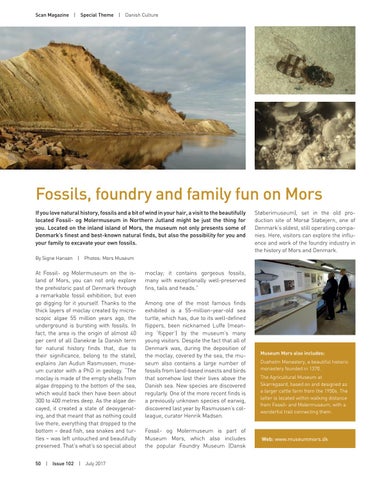Scan Magazine | Special Theme | Danish Culture
Fossils, foundry and family fun on Mors If you love natural history, fossils and a bit of wind in your hair, a visit to the beautifully located Fossil- og Molermuseum in Northern Jutland might be just the thing for you. Located on the inland island of Mors, the museum not only presents some of Denmark’s finest and best-known natural finds, but also the possibility for you and your family to excavate your own fossils.
Støberimuseum), set in the old production site of Morsø Støbejern, one of Denmark’s oldest, still operating companies. Here, visitors can explore the influence and work of the foundry industry in the history of Mors and Denmark.
By Signe Hansen | Photos: Mors Museum
At Fossil- og Molermuseum on the island of Mors, you can not only explore the prehistoric past of Denmark through a remarkable fossil exhibition, but even go digging for it yourself. Thanks to the thick layers of moclay created by microscopic algae 55 million years ago, the underground is bursting with fossils. In fact, the area is the origin of almost 40 per cent of all Danekræ (a Danish term for natural history finds that, due to their significance, belong to the state), explains Jan Audun Rasmussen, museum curator with a PhD in geology. “The moclay is made of the empty shells from algae dropping to the bottom of the sea, which would back then have been about 300 to 400 metres deep. As the algae decayed, it created a state of deoxygenating, and that meant that as nothing could live there, everything that dropped to the bottom – dead fish, sea snakes and turtles – was left untouched and beautifully preserved. That’s what’s so special about 50 | Issue 102 | July 2017
moclay; it contains gorgeous fossils, many with exceptionally well-preserved fins, tails and heads.” Among one of the most famous finds exhibited is a 55-million-year-old sea turtle, which has, due to its well-defined flippers, been nicknamed Luffe (meaning ‘flipper’) by the museum’s many young visitors. Despite the fact that all of Denmark was, during the deposition of the moclay, covered by the sea, the museum also contains a large number of fossils from land-based insects and birds that somehow lost their lives above the Danish sea. New species are discovered regularly. One of the more recent finds is a previously unknown species of earwig, discovered last year by Rasmussen’s colleague, curator Henrik Madsen. Fossil- og Molermuseum is part of Museum Mors, which also includes the popular Foundry Museum (Dansk
Museum Mors also includes: Dueholm Monastery, a beautiful historic monastery founded in 1370. The Agricultural Museum at Skarregaard, based on and designed as a larger cattle farm from the 1950s. The latter is located within walking distance from Fossil- and Molermuseum, with a wonderful trail connecting them.
Web: www.museummors.dk
